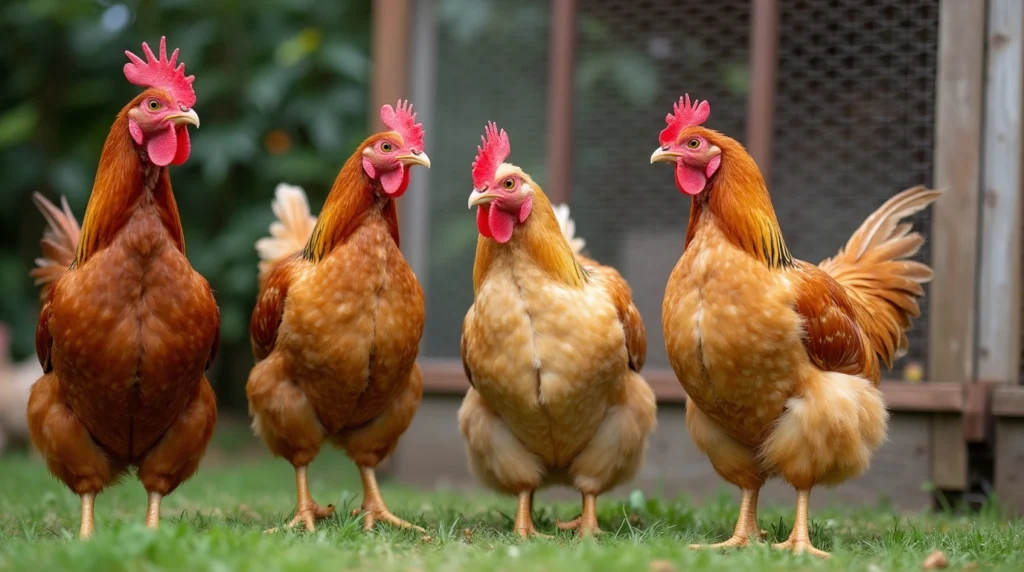Suppose you’re a passionate gardener eager to boost your crop yields while enjoying the companionship of friendly feathered friends. Have you considered integrating dual-purpose chicken breeds into your gardening journey? Imagine a harmonious backyard where chickens peck joyfully among your plants, contributing to pest control and offering fresh eggs simultaneously. In this guide, we’ll explore the incredible advantages of welcoming dual-purpose chickens into your garden, the tools you’ll need, step-by-step instructions for creating an inviting environment for your new pets, common pitfalls to avoid, and expert tips to make the most of this rewarding endeavor.
Table of Contents
Benefits of integrating dual-purpose chicken breeds
Before diving into the nuts and bolts of keeping chickens, let’s take a moment to appreciate all the benefits they can bring to your garden and lifestyle:
- Pest Control: Chickens are nature’s little exterminators; they love munching on insects, weeds, and even small rodents, reducing the need for chemical pesticides.
- Nutrient-Rich Fertilizer: Chicken droppings are an excellent source of nitrogen, perfect for boosting soil fertility. Properly composted, chicken manure becomes an organic fertilizer that can dramatically improve your soil quality.
- Fresh Eggs: Enjoy the delight of farm-fresh eggs with rich flavors that store-bought eggs simply cannot compete with.
- Educational Opportunity: Raising chickens is a fantastic opportunity for families to learn about responsibility, sustainability, and animal care.
- Companionship: Chickens have unique personalities and can be warm, affectionate companions in your garden.
Materials/Tools Needed
Starting a small chicken flock doesn’t require a daunting list of supplies, but a bit of preparation can go a long way. Here’s what you’ll need:
Essential Supplies:
- Coop: A secure henhouse to protect chickens from predators and inclement weather.
- Run Area: A fenced outdoor space for free-range movement that’s safe from threats.
- Nesting Boxes: Comfortable, sheltered spots for hens to lay their eggs; typically, one box for every 2-3 hens is sufficient.
- Feeder and Waterer: Designed to prevent spillage and contamination, ensuring your chickens always have access to clean food and water.
- Bedding Material: Straw, wood shavings, or grass clippings for comfort and cleanliness in the coop.
- Dust Bath: A designated spot filled with sand or fine dirt, allowing chickens to maintain their feathers and relieve pests.
Optional Tools:
- Chicken Harnesses: For supervised outings in your garden.
- Heat Lamp or Insulation: If you live in an area with cold winters, ensure your coop is warm and cozy in the colder months.
Step-by-Step Instructions
1. Choose Your Breeds
Consider breeds that are well-suited for dual-purpose use. Popular choices include:
- Rhode Island Reds: Hardy, adaptable, and great layers.
- Plymouth Rocks: Friendly, good foragers with a good egg-laying rate.
- Orpingtons: Gentle giants that produce a plentiful amount of eggs.
2. Build or Buy a Coop
- Dimensions & Design: Ensure ample space—each chicken requires about 4 square feet inside the coop and 10 square feet in the run.
- Ventilation: Include windows and vents to ensure fresh airflow, minimizing respiratory issues.
- Predator-Proofing: Reinforce entry points and use hardware cloth instead of chicken wire, as it’s more secure.
3. Set Up the Run
- Secure the Run: Bury the bottom of the fence to prevent burrowing predators and cover the top with netting to deter aerial attacks.
- Natural Enrichment: Add logs, sand, and plants to create an engaging environment for your chickens.
4. Prepare Nesting Boxes
- Fill nesting boxes with clean bedding. Encourage your hens to use them by providing privacy and security.
5. Feeding & Maintaining Your Chickens
- Supply a balanced diet of layer pellets and occasional kitchen scraps (avoid toxic foods like avocados and chocolate). Regularly check water supplies.
- Clean the coop and run regularly to prevent bacteria buildup and ensure a healthy environment.
6. Monitoring Health
- Keep an eye out for signs of distress or illness. Regularly check for signs like feather loss, coughing, or lethargy.
Common Mistakes to Avoid

- Neglecting Space: Overcrowding can lead to stress and health issues. Ensure adequate space for each chicken.
- Ignoring Predator Risks: Always fortify the coop and run against potential attackers, including raccoons and hawks.
- Inconsistent Feeding: Maintain a consistent feeding schedule with high-quality feed for peak egg production and health.
- Skipping Regular Health Checks: Monitor your flock’s health proactively to catch issues early.
- Not Providing Enrichment: Bored chickens can become destructive; engage them with toys and space for natural behavior.
Pro Tips from Seasoned Gardeners
- Start Small: If you’re new to chickens, begin with a small flock to learn the ropes before expanding.
- Mix Breeds Carefully: Some chicken breeds have dominant personalities; mix breeds that are known to coexist harmoniously.
- Composting Chicken Manure: Properly compost chicken waste before adding it to your garden to avoid burning your plants.
- Monitor Nesting Behavior: Hens may start brooding; know the signs so you can either support or deter them as needed.
- Rotate Grazing Areas: If possible move the run periodically to fresh ground to prevent soil depletion and parasite buildup.
Seasonal or Climate-Specific Considerations
Spring
- This is an excellent time for integrating new chicks into your coop. Ensure they’re protected from the cooler temperatures at night.
Summer
- Provide ample shade and hydration to prevent overheating. Offering frozen treats like fruits or vegetables in ice can keep them cool.
Fall
- Ideal for preparing your coop for winter. Ensure proper insulation and check for places where drafts may come in.
Winter
- Close off unnecessary vents to maintain warmth; consider heating elements if temperatures drop too drastically for your breed’s comfort.
Natural Pest or Disease Prevention Strategies
- Herbs: Planting herbs like basil, mint, or oregano around the coop acts as natural deterrents against pests while offering a pleasant aroma.
- Diatomaceous Earth: Sprinkling food-grade diatomaceous earth in the coop helps control pests like mites and lice.
- Garlic Water: Some farmers swear by garlic water as a natural antibiotic and pest repellent for their flock.
Companion Planting and Soil Health Suggestions
- Chickens and Gardening: Let your hens scratch and fertilize between growing seasons; they’ll help aerate the soil.
- Planting With Purpose: Use companion planting to grow beneficial plants alongside your flock – for instance, planting marigolds can deter harmful insects while attracting beneficial ones.
- Crop Rotation: Change where you plant each season to maintain healthy soil rich in nutrients, bolstered by your chickens’ natural contributions.
Harvesting and Post-Harvest Care
- Egg Harvesting: Collect eggs daily to prevent breakage and keep them fresh. Clean any dirty eggs with dry methods to avoid washing away protective coating.
- Meat Production: If you choose to raise dual-purpose breeds for meat, plan the timing around the ideal weights (around 16 weeks) for best results.
- Fortifying Soil: After harvest, integrate any leftover greens or plant material into the coop run for chickens to forage, resulting in healthy soil for your next planting season.
FAQs Section
What chicken is best for dual purpose?
The Rhode Island Red is widely considered one of the best dual-purpose chickens. It lays plenty of eggs and has a solid body for meat. Other great options include Plymouth Rock, Orpington, and Australorp.
What is a dual-purpose chicken?
A dual-purpose chicken is a breed raised for both egg production and meat. These birds are typically hardy, easy to manage, and ideal for small farms or backyard flocks where space or resources are limited.
What is the largest dual-purpose chicken?
The Jersey Giant holds the title for the largest dual-purpose breed. They are slow-growing but produce a lot of meat and lay a good number of large brown eggs—great for those who want quantity in both areas.
Are Black Australorps dual purpose?
Yes! Black Australorps are excellent dual-purpose chickens. They’re known for their calm temperament, prolific egg-laying (up to 250–300 eggs per year), and a good-sized body for meat production.
Conclusion
Integrating dual-purpose chickens into your garden isn’t just about the eggs—they’re delightful companions that elevate your gardening experience. With a little effort and care, your flock of chickens will enhance not only your garden’s health but also enrich your life with joy and laughter.
Whether you are an experienced gardener or just getting started, these feathered friends can offer you a sustainable solution to pest control while providing priceless companionship.
So why wait? Start planning your flock today, and prepare for a harmony that only chickens and a flourishing garden can bring!
If you found this guide helpful, share your chicken-raising experience or your favorite breed in the comments below. Happy gardening!
For more gardening tips follow us on Pinterest
